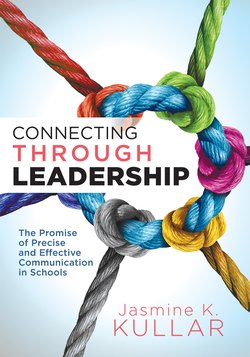Читать книгу Connecting Through Leadership - Jasmine K. Kullar - Страница 5
ОглавлениеTable of Contents
Reproducible pages are in italics.
The Importance of Communication
Chapter 1: Communicating Through Presentations
Chapter 2: Communicating Through Meetings
Chapter 3: Communicating Through Tough Conversations
Chapter 4: Communicating Through Writing
Chapter 5: Communicating Through Body Language
The Five-Month Communication Challenge
Communicating Through Presentations
Structure of Effective Presentations
Advantages and Disadvantages Structure
Problem and Solution Structure
Compare and Contrast Structure
Elements of Ineffective Presentations
Elements of Effective Presentations
Clear Beginning, Middle, and End
Preparation
Dress
PowerPoint
Charisma
Feedback
Summary
Reflection Questions
The School Leader’s Communication Challenge: Presentations
Presentation Preparation Outline
Interactive Strategies for Presentations
Self-Assessment Checklist
SWOT Analysis on My Presentation Skills
Communicating Through Meetings
Types of Meetings
Formal Meetings
Informal Meetings
Purpose of Meetings
Seeking Input
Decision Making
Brainstorming
Resolving Conflict
Information Exchanging
Team Building
Completing Tasks
Elements of Ineffective Meetings
Too Many People
The Wrong People
Lack of Preparation
Too Much Information
Lack of Focus
Unclear Purpose
Too Much Talking
No Closure
Time Issues
Meeting for the Sake of Meeting
Audience Behavior and Meeting Success
The Talkers
The Soundless
The Resistors
The Advocates
The Rebels
The Doubters
The Distracted
The Side Talkers
The Interrupters
The Pessimists
Problematic Behaviors
Communicate Expectations
Hold Attendees Accountable
Elements of Effective Meetings
Beginning—What to Do Before the Meeting
Middle—What to Do During the Meeting
End—What to Do at the End of the Meeting
Summary
Reflection Questions
The School Leader’s Communication Challenge: Meetings
Agenda Template
Meeting Planning Document
Addressing Behaviors in Meetings
Interactive Strategies for Meetings
SWOT Analysis on My Meeting Facilitation Skills
Communicating Through Tough Conversations
Purpose of Tough Conversations
When to Have Tough Conversations
Violation of Laws and Ethics
Violation of School Board Policies
Violation of Local School Procedures
Negativity
Repeat Offenders
Other Situations
Barriers to Tough Conversations
Personal Relationships
Fear of Confrontation
Nothing-Will-Change Attitude
Uncomfortable Topics
Negative Reactions
Time Constraints
Elements of Ineffective Tough Conversations
Frustration
Lack of Preparation
Procrastination
Softened Message
Aggression
Structure of Effective Tough Conversations
Clear Beginning
Clear Middle
Clear End
Summarizing the Structure of Tough Conversations
Connecting Through Tough Conversations
Elements of Effective Tough Conversations
Be Proactive
Before the Conversation
During the Conversation
After the Conversation
Summary
Reflection Questions
The School Leader’s Communication Challenge: Tough Conversations
Our Response to Handbook Violations
Agenda Template
SWOT Analysis on My Ability to Have Tough Conversations
Types of Written Communication
Emails
Letters and Cards
Social Media
Purpose of Written Communication
Advantages and Disadvantages of Written Communication
Advantages of Written Communication
Disadvantages of Written Communication
Elements of Effective Written Communication
Use Clear Verbiage
Edit for Correctness and Clarity
Be Professional
Know Your Audience
Keep to Your Purpose
Summary
Reflection Questions
The School Leader’s Communication Challenge: Writing
Sample Letter of Concern Template
Sample Informational Letter Template
Sample Survey
Sample Communication Plan Template
SWOT Analysis on My Writing Skills
Communicating Through Body Language
Impact of Body Language Communication
Repetition
Contradiction
Substitution
Complementing
Accenting
What Body Language Can Communicate
Demonstrate Personal Qualities
Establish Hierarchy
Promote Social Functioning
Foster High-Quality Relationships
Display Emotions
Dress to Impress
Observing Body Language
Elements of Effective Body Language
Be Self-Aware
Share Appropriately
Manage Your Mood
Take Time to Respond, Instead of React
Look for Solutions Instead of Blame
Body Language for Leaders
Summary
Reflection Questions
The School Leader’s Communication Challenge: Body Language
Body Language Look-Fors in Others
Body Language Indicators for Emotions
The Dos and Don’ts of Body Language Communication
SWOT Analysis on My Body Language
